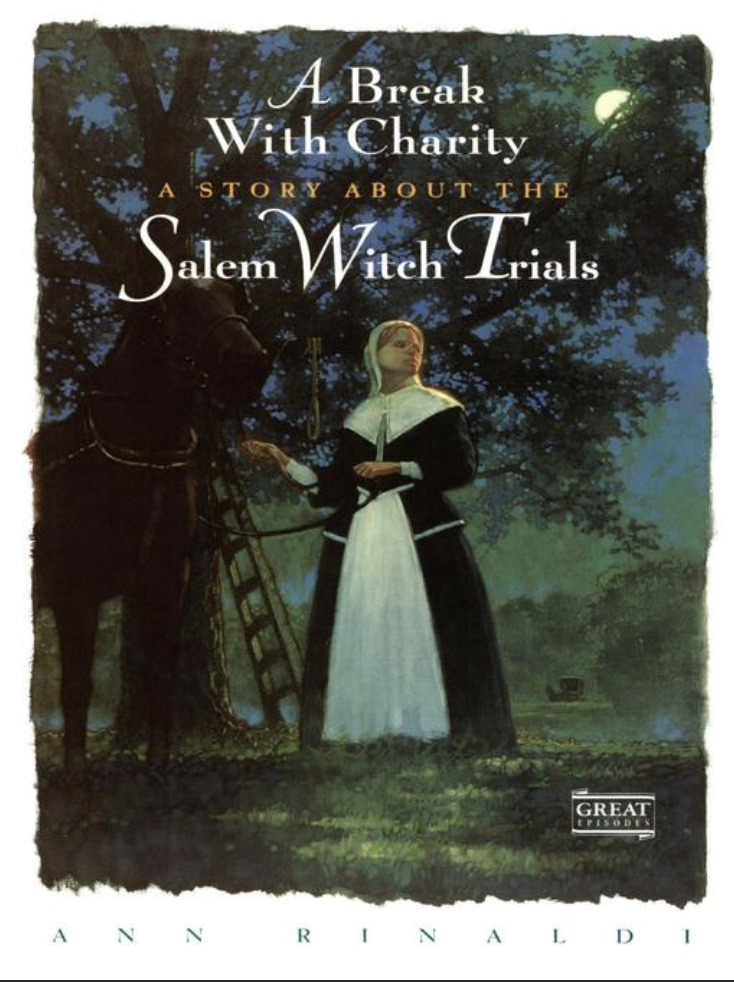In my review of Hattie Big Sky, I mentioned that I have a voracious reader who is a sixteen-year-old girl with classical taste in books. Finding “new” things for her is challenging but, thanks to Sherry Early of Meriadoc Homeschool Library, exciting. Sherry has been making beautiful lists for me to work through, like this one. Many of these titles and authors are entirely new to me, so I am having the joy of meeting lovely new authors for the first time. On at least one of the lists from Sherry was historical fiction author Ann Rinaldi. When looking for Rinaldi books that I could preview via Audible, I selected A Break With Charity. I don’t know a great deal about the Salem Witch Trials, but having recently read Downright Dency, I was curious about the general idea.

This book is utterly compelling.
In the Author’s Note at the end of the book, Rinaldi explains that her research into the Puritan era revealed that “people went right from childhood into adulthood, with no benefit of an awkward age in between. An orphaned child was allowed to choose his or her own guardians at the age of fourteen; the laws applied to all persons of the age of sixteen, which was also the age at which boys were liable to serve in the military. On the other hand, the average age for marriage was twenty-two for women and twenty-seven for men… They had no amusements or entertainment. Music, dancing, and even the traditional holiday of Christmas were forbidden. Toys were nonexistent. Anyone caught with a doll or “poppet” was suspected of practicing forbidden arts. Meeting on Sunday lasted several hours. Reading consisted of studying the Bible.”
Rinaldi goes on to explain that children were raised to work and to worship God. The rules were very strict. People, however, were people. Teenagers were particularly susceptible to inventing entertainment for themselves, regardless of how forbidden. Long winters, harsh rules, and boredom were the breeding grounds for the hysteria in 1692.
Rinaldi’s historical fiction invites the reader into true historical events with front seats to the action. She lets us see what is happening through the eyes of someone who was actually there. In Salem, however, none of the girls in the circle of accusers were sympathetic characters. Instead, Rinaldi scrupulously researched the lives of others in the town and allowed us to look through the eyes of Susanna English.
Susanna English is the daughter of Phillip English. Phillip English was considered gentry because he was a merchant and traded with the English. While he and his wife lived in Salem, and were generous with the people of Salem, they were considered outsiders. Additionally, Phillip English was skeptical of the Puritan ways and did not worship with them. Interestingly, his daughter Susanna would go on to marry the son of Magistrate, John Hathorne. Hathrone persecuted and arrested Susanna’s parents during the witch trials. In Susanna, we have a very complex and interesting character who doesn’t properly fit anywhere. Her perspective helps us to see the story from multiple sides and to better sympathize with the many in Salem who failed to stop the trials sooner because of their own legitimate fears of being accused.
This book is very well drawn. It is fascinating, complex, and historically rich. I enjoyed reading it immensely and would love to reread it with teens in a book club.